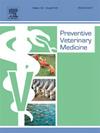在塞拉利昂未接种疫苗的狗的主人中,与犬狂犬病疫苗接种障碍相关的因素。
IF 2.4
2区 农林科学
Q1 VETERINARY SCIENCES
引用次数: 0
摘要
犬只接种疫苗是预防狂犬病病毒传播和人类死亡的最有效方法。然而,在塞拉利昂,疫苗接种率仍然很低,不接种疫苗的原因也没有得到很好的了解。我们使用分层贝叶斯多项式回归分析了2023个家庭调查数据,以深入了解未接种疫苗的狗的主人对犬狂犬病疫苗接种的感知障碍。我们的结果表明,在接受采访的2558个养狗家庭中,只有14 %(358)报告他们的狗完全接种了疫苗。在2200名未接种狂犬病疫苗的受访者中,大多数(71.6 %)不知道如何获得狂犬病疫苗接种服务,17.6 %的人认为费用,10.8 %的人认为不重要。模型的后验分布表明,城市居民认为狂犬病疫苗接种不重要的几率比农村居民低91 % (OR = 0.11, 95 % CrI: 0.02-0.34)。同样,受过高等教育的个体认为狂犬病疫苗接种不重要的几率要低28 % (OR = 0.72, 95 % CrI: 0.31-1.59),尽管这种影响是不确定的,尽管有80 %的可能性具有保护作用。没有兽医服务地区的答复者更有可能将费用列为障碍。学生认为狂犬病疫苗接种不重要的可能性显著低于公务员(OR = 0.41, 95 % CrI: 0.17-0.95)。相比之下,自由流浪狗的主人认为狂犬病疫苗接种不重要的可能性是前者的两倍(OR = 2.41, 95 % CrI: 1.15-5.59)。那些部分限制狗的人更有可能报告不知道如何获得狂犬病疫苗接种服务(OR = 1.99, 95 % CrI: 1.39-2.86)。与以费用为理由的家庭相比,东部省份的家庭认为疫苗不重要的可能性要小得多。西部地区的受访者不太可能将成本视为障碍。相比之下,东部地区的家庭更有可能将成本视为一个障碍。这些发现表明,塞拉利昂犬类疫苗接种的障碍是由信息、社会经济和地理因素共同造成的。提高公众意识,特别是在农村地区,并扩大获得兽医服务的机会,可能有助于解决主要障碍。建议考虑教育水平、职业类型和当地基础设施的量身定制的外展战略,以加强疫苗接种并支持狂犬病预防工作。本文章由计算机程序翻译,如有差异,请以英文原文为准。
Factors associated with perceived barriers to canine rabies vaccination among owners of unvaccinated dogs in Sierra Leone
Dog vaccination is the most effective method for preventing rabies virus transmission and human deaths. However, in Sierra Leone, vaccination rates remain low, and the reasons for non-vaccination are not well understood. We analysed 2023 household survey data using a hierarchical Bayesian multinomial regression to provide insight into perceived barriers to canine rabies vaccination among owners of unvaccinated dogs. Our results indicated that of the 2558 dog-owning households interviewed, only 14 % (358) reported having fully vaccinated their dogs. Of the 2200 respondents with unvaccinated dogs, most (71.6 %) didn’t know how to access rabies vaccination services, 17.6 % cited cost, and 10.8 % believed it was unimportant. Posterior distribution of our model showed that urban residents had 91 % lower odds of believing rabies vaccination was unimportant compared to rural residents (OR = 0.11, 95 % CrI: 0.02–0.34). Similarly, individuals with tertiary education had 28 % lower odds of believing rabies vaccination was unimportant (OR = 0.72, 95 % CrI: 0.31–1.59), though this effect is uncertain despite an 80 % probability of being protective. Respondents in areas without veterinary services were more likely to cite cost as a barrier. Students were significantly less likely than civil servants to consider rabies vaccination unimportant (OR = 0.41, 95 % CrI: 0.17–0.95). In contrast, owners of free-roaming dogs were significantly twice as likely to believe that rabies vaccination was unimportant (OR = 2.41, 95 % CrI: 1.15–5.59). Those with partially confined dogs were significantly more likely to report not knowing how to access rabies vaccination services (OR = 1.99, 95 % CrI: 1.39–2.86). Compared to households citing cost, those in the Eastern Province were significantly less likely to report that the vaccine is unimportant. Respondents in the Western Area were significantly less likely to report cost as a barrier. In contrast, households in the Eastern were more likely to report cost as a barrier. These findings suggest that barriers to dog vaccination in Sierra Leone are shaped by a combination of informational, socioeconomic, and geographic factors. Improving public awareness, especially in rural areas, and expanding access to veterinary services could help address key obstacles. Tailored outreach strategies that consider education levels, occupation types, and local infrastructure are recommended to enhance vaccination uptake and support rabies prevention efforts.
求助全文
通过发布文献求助,成功后即可免费获取论文全文。
去求助
来源期刊

Preventive veterinary medicine
农林科学-兽医学
CiteScore
5.60
自引率
7.70%
发文量
184
审稿时长
3 months
期刊介绍:
Preventive Veterinary Medicine is one of the leading international resources for scientific reports on animal health programs and preventive veterinary medicine. The journal follows the guidelines for standardizing and strengthening the reporting of biomedical research which are available from the CONSORT, MOOSE, PRISMA, REFLECT, STARD, and STROBE statements. The journal focuses on:
Epidemiology of health events relevant to domestic and wild animals;
Economic impacts of epidemic and endemic animal and zoonotic diseases;
Latest methods and approaches in veterinary epidemiology;
Disease and infection control or eradication measures;
The "One Health" concept and the relationships between veterinary medicine, human health, animal-production systems, and the environment;
Development of new techniques in surveillance systems and diagnosis;
Evaluation and control of diseases in animal populations.
 求助内容:
求助内容: 应助结果提醒方式:
应助结果提醒方式:


